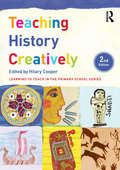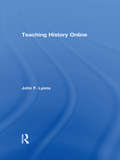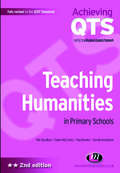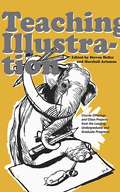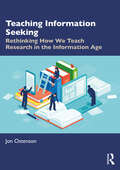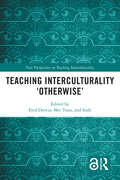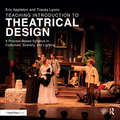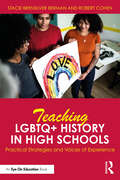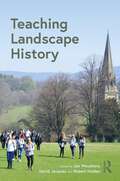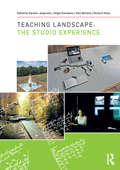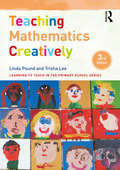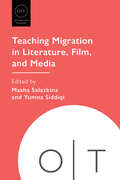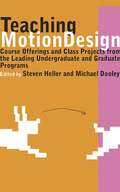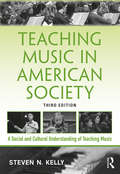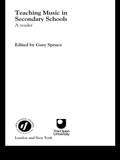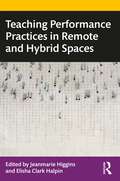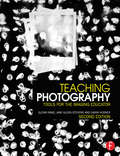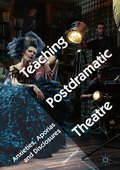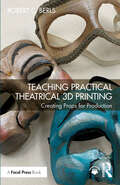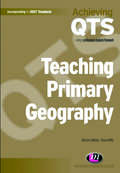- Table View
- List View
Teaching History Creatively
by Hilary CooperFresh and innovative, Teaching History Creatively will foster creativity in both learners and practitioners alike. By introducing teachers to a wealth of available approaches to historical enquiry, this book ensures creative, active and effective learning which includes plenty of challenges, clear goals and opportunity for progression. Underpinned by theory and research, it offers informed and practical support, illustrated throughout by examples of children’s work. Key themes addressed include: how good history education and creativity are inseparable; investigating sources: archaeology, visits and time capsules; using archives in your own research project; historical agents and history detectives!; drama for exploring events, myths and legends; communicating historical understanding creatively. Written by experienced authors with extensive experience of history teaching in the primary school, Teaching History Creatively is an essential purchase for any professional who wishes to embed creative approaches to teaching in their classroom.
Teaching History Creatively (Learning To Teach In The Primary School Ser.)
by Hilary CooperThe fully updated second edition of Teaching History Creatively introduces teachers to the wealth of available approaches to historical enquiry, ensuring creative, effective learning. This book clearly sets out the processes of historical enquiry, demonstrating how these are integrally linked with key criteria of creativity and helps readers to employ those features of creativity in the classroom. Underpinned by theory and research, it offers informed and practical support and is illustrated throughout with examples of children’s work. Key themes addressed include: investigating sources using archives in your own research project becoming historical agents and history detectives drama for exploring events myths and legends communicating historical understanding creatively. With brand new chapters from the Stone Ages to the Iron Age, using prehistoric sources; The withdrawal of the Romans and the conquest and settlement of Britain by the Anglo-Saxons, in addition to many new case studies, this exciting edition puts an emphasis on accessible, recent research, new evidence and interpretations and encourages the creative dynamism of the study of history. Teaching History Creatively provides vivid and rich examples of the creative use of sources, of approaches to understanding chronology and concepts of time and of strategies to create interpretations. It is an essential purchase for any teacher or educator who wishes to embed creative approaches to teaching history in their classroom.
Teaching History Online
by John F. LyonsBringing history teaching into the twenty-first century, Teaching History Online is a concise guide to developing and using internet resources in history instruction. It offers practical, jargon-free advice to help the history teacher develop online assignments, and provides an informed introduction to the myriad resources and tools available for use in the online classroom. Beginning with a chapter on the benefits of teaching and studying online, John F. Lyons goes on to address instructors’ most commonly asked questions and concerns, including: designing an online class providing online alternatives to the lecture developing a user-friendly discussion board conducting assessment and dealing with classroom management issues. For historians interested in providing an online element to their traditional face-to-face classroom teaching, the final chapter shows how to develop successful hybrid/blended classes. An accessible introduction and valuable resource, Teaching History Online includes sample lesson plans, examples of online learning tools, and suggestions for further reading, helping those who use – or want to use – online resources to create exciting, interactive and rewarding learning environments. Visit the companion website, which includes extra reading and resources information at: www.routledge.com/textbooks/9780415482226.
Teaching Humanities in Primary Schools (Achieving QTS Series)
by Pat Hoodless Paul Bowen Susan Bermingham Elaine McCreeryThis book supports primary trainees in their learning and teaching approach to the core humanities subjects: geography, history and religion. It promotes an integrated approach to these subject areas and encourages trainees to reflect on the links between subjects, across the curriculum from the Early Years Foundation Stage through to Key Stage 2. This edition has been updated to incorporate the revised Professional Standards for the Award of QTS and addresses key initiatives such as Excellence and Enjoyment, Every Child Matters and the Primary National Strategy for Literacy and Mathematics.
Teaching Illustration: Course Offerings and Class Projects from the Leading Graduate and Undergraduate Programs
by Steven Heller Marshall ArismanTeaching Illustration is a must-have for any college-level art instructor. Packed with a wealth of illustration course syllabi from leading art and design schools across the U.S. and Europe, it offers exciting ideas on topics from editorial illustration to animation, books, and the Internet. Each syllabus includes an introduction, course requirements, a weekly breakdown, suggestions for projects, and selected readings-a comprehensive array of topics, reading lists, and teaching tips for courses at all levels. For beginning educators seeking guidance or for veterans seeking new inspiration, Teaching Illustration is essential for the craft of teaching the next generation of illustrators. Packed with sample syllabi-a must-have for art teachers and students Detailed, concrete examples of how to create compelling, inspiring classes
Teaching Information Seeking: Rethinking How We Teach Research in the Information Age
by Jon OstensonTeaching Information Seeking redefines how we approach research and information literacy in today's information-rich world, inviting teachers to re-imagine teaching research.The book combines insights from fields such as library and information sciences, journalism, and media literacy to offer fresh strategies and perspectives for guiding students through evolving landscapes of information.While a focus on concepts and skills has long been important in teaching research, this book integrates significant new understandings about the role dispositions play in how well students embrace and utilize skill-based knowledge. The book provides conceptual knowledge and learning activities that support writing teachers as they help students learn throughout the research or inquiry process of asking questions, finding information, and sharing their learning purposefully and ethically. Chapters with a pedagogical focus and approach include activities informed by the author’s decades of experience teaching writing. These activities are described in depth, including assignment prompts, sample work, and scripts for think-aloud protocols and discussions the author has led that engage students in deeper learning around these critical skills and dispositions. Teaching Information Seeking serves as a comprehensive guide for educators looking to foster meaningful information literacy and critical thinking skills in their students.This book is ideal for teachers and teacher educators who want to equip students with the skills and dispositions needed for effective research and information literacy. Readers will find teacher-friendly, research-grounded insights and activities that can be readily applied in the classroom.
Teaching Innovation in Architecture and Building Engineering: Challenges of the 21st century
by David Bienvenido-Huertas María Luisa de la Hoz-Torres Antonio Jesús Aguilar AguileraThis book presents contributions on teaching innovation in university architecture and building engineering studies. The authors explain how the construction sector demands that future architects and building engineers have the knowledge and skills that allow them to meet the decarbonization objectives established by international organizations and that this causes the level of knowledge to be higher. The contributors further discuss new technologies and the internationalization of studies presenting new challenges university studies must face. This heterogeneity is represented in the chapters that make up this book developed by researchers from different countries. The book is divided into three blocks: (i) Active learning methodologies; (ii) Innovative methodologies applied to learning process; and (iii) Traditional vs. Advanced Techniques. The chapters of the book represent an advance in the current knowledge of teaching innovation techniques in university architecture and building engineering studies.
Teaching Interculturality 'Otherwise' (New Perspectives on Teaching Interculturality)
by Fred Dervin, Mei Yuan, and SudeThis edited volume focuses on the thorny and somewhat controversial issue of teaching (and learning) interculturality in a way that considers the notion from critical and reflexive perspectives when introduced to students. Comprised of three parts, the book discusses the nuts and bolts of teaching interculturally, considers changes in the teaching of interculturality, and provides pedagogical insights into interculturalising the notion. It studies both teaching im-/explicitly about interculturality and how to incorporate interculturality into teaching practices or into an institution. By sharing varied cases and theoretical reflections on the topic, the editors and contributors from different parts of the world aim to stimulate more initiatives to enrich the field instead of delimiting it, especially in complement to and beyond the 'West' or 'Global North', and also to build up further reflexivity in the way readers engage with interculturality in education. This will be a must-read for teachers and researchers of intercultural communication education at different educational levels, as well as anyone interested in scholarship on education for interculturality.
Teaching Introduction to Theatrical Design: A Process Based Syllabus in Costumes, Scenery, and Lighting
by Eric Appleton Tracey LyonsTeaching Introduction to Theatrical Design is a week-by-week guide that helps instructors who are new to teaching design, teaching outside of their fields of expertise, or looking for better ways to integrate and encourage non-designers in the design classroom. This book provides a syllabus to teach foundational theatrical design by illustrating process and application of the principals of design in costumes, sets, lights, and sound.
Teaching Kids to Read: Embracing Guided Reading in Primary School Classrooms
by Gail Saunders-Smith"A solid resource to help teachers understand the basic foundation for literacy development through guided reading in the primary grade." —Patti Ulshafer, first-grade teacherDevelop successful readers with these strategies for before, during, and after reading. In Teaching Kids to Read, Gail Saunders-Smith describes the cognitive processes of emergent readers and provides educators with clear guidelines for promoting reading comprehension with small groups of young learners. A variety of exercises included helps children to locate, record, retrieve, and manipulate information from texts while enabling teachers to measure how students respond in oral, written, graphic, and three-dimensional forms. Topics covered include:AliteracyCoaching statementsElements of craftFalse positive readersFresh textGuided readingInstructional practiceMetacognitionPhonemic awarenessSelf-monitoringShared readingSight wordsStudy skillsTeacher talkWorkable wordsand more!
Teaching LGBTQ+ History in High Schools: Practical Strategies and Voices of Experience
by Robert Cohen Stacie Brensilver BermanTeaching LGBTQ+ History in High Schools: Practical Strategies and Voices of Experience offers insights, concrete strategies, and lesson plans for teaching LGBTQ+ history in high schools. With essays from educators, historians, and activists, it speaks to the power and significance of LGBTQ+-inclusive curriculum and its greater necessity at a time when the LGBTQ+ community is both more visible and increasingly targeted.Across the US, challenges exist that prevent teaching LGBTQ+ history, including curriculum censorship laws prohibiting discussion of the LGBTQ+ community in schools. However, there are also grassroots movements in the US that are generating quality LGBTQ+ history curriculum and implementing them in secondary schools. This book shows how integrating LGBTQ+ content offers myriad benefits for all students, including making history more relevant and representative, and reversing years of silence and erasure in the sources, topics, and narratives that students encounter throughout their education.Combining insights from changemakers with practical strategies and lesson plans for teaching LGBTQ+ history, this book will equip educators with the rationale and resources they need to effectively integrate this history into the curriculum. It will also be highly valuable for pre-service teachers, particularly within Social Studies Education and Social Justice Education.
Teaching Labor History in Art and Design: Capitalism and the Creative Industries (Routledge Studies in Education, Neoliberalism, and Marxism)
by Kyunghee Pyun Vincent G. QuanDrawing from American history, fashion design, history of luxury, visual culture, museum studies, and women’s history, among others, this book explores the challenges, rewards and benefits of teaching business and the labor history of art and design professions to those in higher education.Recognizing that artists and designers are no longer just creatives, but bosses, employees, members of professional associations, and citizens of nations that encourage and restrain their creative work in various ways, the book identifies a crucial need for art and design students to be taught the intricacies of these other roles, as well as how to navigate or challenge them. This empirically driven study features case studies in various pedagogical contexts, including museum exhibitions, group projects, lesson plans, discussion topics, and long-term assignments. The chapters also explore how the roles of designing and making became separated, how new technologies and the rise of mass production affected creative careers, the shifts back and forth between direct employment and freelancing, and the evolution of government interventions in creative fields.With a diverse and experienced range of contributors, and providing a unique set of conceptual tools to interpret, cope with, and react to the ever-changing conditions of capitalism, this volume will appeal to educators and researchers across education, history, art history, and sociology, with interests in experiential learning, capitalism, equity, social justice and neoliberalism.
Teaching Landscape History
by Jan Woudstra David JacquesLandscape history is changing in content and style to address the issues of today. Experienced teachers and authors on the history of gardens and landscapes come together in this new volume to share ideas on the future of teaching history in departments of landscape architecture, archaeology, geography and allied subjects. Design history remains important, but this volume brings to the fore the increasing importance of environmental history, economic history, landscape history, cultural landscapes, environmental justice and decolonisation, ideas of sustainability and climate change amelioration, which may all be useful in serving the needs of a widening range of students in an increasingly complex world. The main themes include: what history should we narrate in the education of landscape architects? how can we recognise counter-narratives and our own bias? how should we engage the students in the history of their chosen profession? how can designers and researchers be persuaded of the relevance of history teaching to theory and practice? and what resources do we need to develop teaching of landscape histories? This book will be of interest to anyone teaching courses on landscape architecture, urban design, horticulture, garden design, architectural history, cultural geography and more.
Teaching Landscape: The Studio Experience
by Karsten Jørgensen Nilgül Karadeniz Elke Mertens Richard StilesTeaching Landscape: The Studio Experience gathers a range of expert contributions from across the world to collect best-practice examples of teaching landscape architecture studios. This is the companion volume to The Routledge Handbook of Teaching Landscape in the two-part set initiated by the European Council of Landscape Architecture Schools (ECLAS). Design and planning studio as a form of teaching lies at the core of landscape architecture education. They can simulate a professional situation and promote the development of creative solutions based on gaining an understanding of a specific project site or planning area; address existing challenges in urban and rural landscapes; and often involve interaction with real stakeholders, such as municipality representatives, residents or activist groups. In this way, studio-based planning and design teaching brings students closer to everyday practice, helping to prepare them to create real-world, problem-solving designs. This book provides fully illustrated examples of studios from over twenty different schools of landscape architecture worldwide. With over 250 full colour images, it is an essential resource for instructors and academics across the landscape discipline, for the continuously evolving process of discussing and generating improved teaching modes in landscape architecture.
Teaching Mathematics Creatively (Learning to Teach in the Primary School Series)
by Trisha Lee Linda PoundThis revised and updated third edition offers a range of strategies, activities and ideas to bring mathematics to life in the primary classroom. Taking an innovative and playful approach to maths teaching, this book promotes creativity as a key element of practice and offers ideas to help your students develop knowledge, understanding and enjoyment of the subject. In the creative classroom, mathematics becomes a tool to build confidence, develop problem solving skills and motivate children. The fresh approaches explored in this book include a range of activities such as storytelling, music and construction, elevating maths learning beyond subject knowledge itself to enable students to see mathematics in a new way. Key chapters of this book explore: • Learning maths outdoors - make more noise, make more mess or work on a larger scale • Everyday maths - making sense of the numbers, patterns, shapes and measures children see around them • Music and maths – the role of rhythm in learning, and music and pattern in maths Stimulating, accessible and underpinned by the latest research and theory, this is essential reading for trainee and practising teachers who wish to embed creative approaches to maths teaching in their classroom.
Teaching Migration in Literature, Film, and Media (Options for Teaching)
by Yumna Siddiqi Masha SalazkinaPeople migrate to seek opportunities, to unite with family, and to escape war, persecution, poverty, and environmental disasters. A phenomenon that has real, lived effects on individuals and communities, migration also carries symbolic, ideological significance. Its depiction in literature, film, and other media powerfully shapes worldviews, identities, attitudes toward migrants, and a political landscape that is both local and global. It is imperative, then, to connect the disciplinary and theoretical tools we have for understanding migration and to put them in conversation with students' experiences.Featuring a wide range of classroom approaches, this volume brings together topics that are often taught separately, including tourism, slavery, drug cartels, race, whiteness, settler colonialism, the Arab Spring, assimilation, and disability. Readers are introduced to terminology and legal frameworks and to theories of migration in relation to Black studies, ethnic studies, Asian American studies, Latinx studies, border studies, postcolonial studies, and Indigenous studies.
Teaching Motion Design: Course Offerings and Class Projects from the Leading Graduate and Undergraduate Programs
by Steven Heller Michael DooleyHow motion design is taught in more than 45 leading programs. * Detailed syllabi and descriptions of class projects and assignments * Go-to guide for professors and teachers planning their courses * Course plans from School of Visual Arts, Ohio State, Rochester Institute of Technology, many other top schools. This definitive study of motion design is essential reading for everyone teaching or studying design. Now, for the first time, authors Steven Heller and Michael Dooley present a comprehensive look at course offerings from more than 45 leading programs devoted to design, illustration, animation, and computer art. Taken together, they provide a close-up look at the principles and practices of 3D computer animation, character animation, pictorial background illustration, motion graphic design, interactive media, film design, and more, with class projects and syllabi from many of the most prestigious schools in the country. Organized in easy-to-use sections by year of study, this invaluable tool will be every graphic design educator's go-to guide.
Teaching Music in American Society: A Social and Cultural Understanding of Teaching Music
by Steven N. KellyTeaching Music in American Society, Third Edition, provides a comprehensive overview of social and cultural themes directly related to music education, teacher training, and successful teacher characteristics. Music teachers need to be not only knowledgeable in conducting and performing but also socially and culturally aware of students, issues, and events that affect their classrooms. This book is designed for educators seeking K-12 music teacher certification to teach in American schools. At the conclusion of each chapter is a summary of the chapter and a list of key items and people discussed, plus a series of related questions for students to consider. Current topics in the third edition include: • an emphasis on social justice, sensitivity to transgender students, and bullying, • the influences of social media, • a focus on urban music education, and • a new chapter on diverse learning. Further, recent policy issues are addressed in this new edition: • the evolution of the No Child Left Behind Act into the Every Student Succeeds Act, • the increasing emphasis on charter schools, the privatization of public school, • changes in how schools are assessed, and • changes occurring within the teaching profession—and how all of these affect developments in music education. A major structural change is the chapter on equality of education has been split into two chapters, providing a stronger focus on both educational equality and diverse inclusive learning.
Teaching Music in Secondary Schools: A Reader (Ou Flexible Pgce Ser.)
by Gary SpruceTeaching Music in Secondary Schools is the accompaniment to its practical-based counterpart Aspects of Teaching Secondary Music. Together they form a comprehensive resource for those engaged with Initial Teacher Training and Continuing Professional Development in Music. Through this reader, student-teachers and practising teachers will be introduced to the big issues and ideas abounding in music teaching today.
Teaching Performance Practices in Remote and Hybrid Spaces
by Jeanmarie HigginsThis collection of insightful essays gives teachers’ perspectives on the role of space and presence in teaching performance. It explores how the demand for remote teaching can be met while at the same time successfully educating and working compassionately in this most ‘live’ of disciplines. Teaching Performance Practices in Remote and Hybrid Spaces reframes prevailing ideas about pedagogy in dance, theatre, and somatics and applies them to teaching in face-to-face, hybrid, and remote situations. Case studies from instructors and professors provide essential, practical suggestions for remotely teaching a vast range of studio courses, including tap dance, theatre design, movement, script analysis, and acting, rendering this book an invaluable resource. The challenges that teachers are facing in the early twenty-first century are addressed throughout, helping readers to navigate these unprecedented circumstances whilst delivering lessons, guiding workshops, rehearsing, or even staging performances. This book is invaluable for dance and theatre teachers or leaders who work in the performing arts and related disciplines. It is also ideal for any professionals who need research-based solutions for teaching performance online.
Teaching Photography: Tools for the Imaging Educator (Photography Educators Series)
by Glenn Rand Garin Horner Jane Alden StevensThe photographic community is rife with talented and creative practitioners and artists. But making great photographs does not always translate into an ability to teach effectively. This new edition of Teaching Photography approaches photographic education from a point of view that stresses the how and why of the education. It includes the resources that will inspire new and seasoned teachers to help students expand their technical and aesthetic abilities and techniques, as well as their visual literacy and the way photography fits into the wider world. Fully updated to include the online/hybrid classroom environment, collaborative learning, rubrics, and using digital technology, plus techniques for inspiring conversations and critiques.
Teaching Postdramatic Theatre: Anxieties, Aporias and Disclosures
by Glenn D’CruzThis book explores the concept and vocabulary of postdramatic theatre from a pedagogical perspective. It identifies some of the major anxieties and paradoxes generated by teaching postdramatic theatre through practice, with reference to the aesthetic, cultural and institutional pressures that shape teaching practices. It also presents a series of case studies that identify the pedagogical fault lines that expose the power-relations inherent in teaching (with a focus on the higher education sector as opposed to actor training institutions). It uses auto-ethnography, performance analysis and critical theory to assist university teachers involved in directing theatre productions to deepen their understanding of the concept of postdramatic theatre.
Teaching Practical Theatrical 3D Printing: Creating Props for Production
by Robert C. BerlsTeaching Practical Theatrical 3D Printing: Creating Props for Production is a cohesive and practical guide for instructors teaching 3D printing techniques in stagecraft, costume and props courses.Written for the instructor, this book uses non-technical language to explain 3D printers, their workflows and products. Coverage includes the ins and outs of multiple filaments, pros and cons of different types of printers, shop or laboratory setup and safety concerns. The book features lesson plans, rubrics and class-tested sample student projects from design to finished product that highlight learning objectives and methodologies, as well as software and hardware usage explanations and common problems that can occur within design and printing. Step-by-step instructions are included for many types of projects, including fake noses, candlestick phones, buttons, 3D scans, historical recreations and linear actuators. The book also contains examples of poor, average and excellent work with grading explanations and guidance on how to help the student move to the next level with their projects. Chapter objectives, chapter summaries, checklists and reflection points facilitate an instructor in gaining confidence with 3D printers and incorporating their use in the classroom.Teaching Practical Theatrical 3D Printing is an excellent resource for instructors of Props and Costume Design and Construction courses that are interested in using state of the art tools and technology for theatre production.Fully editable files for every object featured in the book are available at www.routledge.com/9781032453279, allowing readers to jump-start their projects and giving them the flexibility to change and redesign the items to best fit their needs.
Teaching Primary Art and Design (Achieving QTS Series)
by Paul Key Jayne StillmanThis book introduces trainees and newly qualified primary teachers to the teaching of art and design in primary schools. It helps students gain an appreciation of what constitutes good practice in primary art and design and how they can go about achieving it. To meet the different needs of students, the book identifies varying levels of experience, creativity and confidence, and offers suggestions for applying these levels to the classroom. The book covers key areas of the art and design curriculum for Early Years Foundation Stage, Key Stage 1 and Key Stage 2, considering both their discrete and developmental characteristics.
Teaching Primary Geography (Achieving QTS Series)
by Simon Catling Tessa WillyWritten with reference to the 2007 Professional Standards for the Award of QTS and initiatives such as the Primary National Strategy, each chapter offers practical guidance on topics such as planning, assessment and the creation of resources. It provides summaries of key topics in primary geography, including the study of places, environmental sustainability, learning beyond the classroom, global issues, citizenship and cross-curricular approaches to promote children’s subject knowledge, well-being and learning within primary geography. With research summaries, practical and reflective tasks, and classroom examples, this book helps trainees and NQTs teach primary geography confidently and creatively throughout the primary school.

